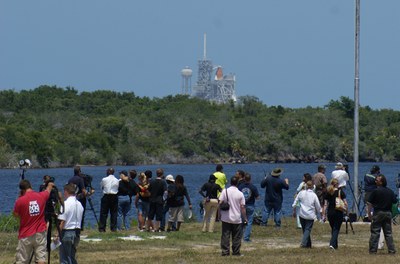At the altar of smoke and fireby Dwayne A. Day
|
| Many of the photographers, perhaps most of them, were regulars. There were guys there who had seen every shuttle launch. |
During the 1990s the shuttle had become boring again, routine. The public had forgotten about Challenger and gone back to ignoring the launches. CNN was still covering them, and only felt compelled to keep the cameras running until SRB separation, after which they cut to a laxative commercial because nothing bad ever happens after SRB separation. And the shuttle wasn’t really launching anything interesting. Oh, the first mission to Mir was interesting, as was the second. But that got old fast.
It was remarkably easy to get a press pass to the launch site in the 1990s. I had written a few articles for Ad Astra magazine and knew the editor, and all I had to do was ask him to fax a letter to the Kennedy Space Center Public Affairs Office saying that I was there to cover a launch. The press site is really the best place to watch a shuttle launch unless you actually work on site and can get a little closer. So I got on site, usually with a friend who also got credentialed. I’m sure that I wrote an article or two to justify my attendance.
The big countdown clock alongside the flag that you see in a lot of the launch footage is at the front of the press site. There used to be a set of covered bleachers at the rear, along with some tents and trailers. For the launches I went to, sometimes a contractor would set up a trailer to give out press materials like brochures about the shuttle payload, stickers, and similar things. They probably had better swag for the iconic reporters like Bill Harwood and Craig Covault. But the closer it got to launch time, the more the concrete pad in front of the bleachers and the grass leading up to the countdown clock became covered with camera tripods. People milled about and talked.
Many of the photographers, perhaps most of them, were regulars. There were guys there who had seen every shuttle launch—90 plus launches by the latter 1990s. They told stories about how, after Challenger blew up, NASA confiscated all of their film as evidence. Some of them had been there to photograph some of the Saturn V launches almost three decades earlier. And what I realized when talking to a few of them was that they were groupies.
Some of them were what you’d call professional photojournalists, guys (they were all guys) who worked for AP or Reuters who got sent all over the world to photograph events. Maybe a few were war photographers, action junkies who got off on the guns and the bombs. There was one guy who was a professional fashion photographer who regularly photographed models for the covers of Vogue and Cosmopolitan.
| The guys were regulars, there for every shuttle launch, not so much because it was a job, but because it was some kind of calling. They were there because—damn it, it was cool! |
There was another guy who was apparently independently wealthy (oil wells? I cannot remember) who came out for every shuttle launch. My friend asked him what he got paid for a shuttle launch photo. I think it was a couple thousand dollars plus expenses, maybe less if there was other news to crowd out the market. He didn’t need the money. He did it for the fix.
A few of the guys were hardcore: they had remote cameras closer to the pad for more spectacular photos. Some of them eschewed the press site entirely, trying to get entirely new angles and photos that don’t look like every other photographer’s shots. I got the sense that those guys weren’t really part of the same clan. They weren’t there to reconnect with their buddies, they were there for the challenge.
It’s not easy to photograph a shuttle launch, especially one at night. It takes some expertise to deal with the contrast and the movement. Nevertheless, the guys were regulars, there for every shuttle launch, not so much because it was a job, but because it was some kind of calling. They were there because—damn it, it was cool!
They’ll be there for the last two shuttle launches. Probably some of them have come out of retirement to go back and photograph the last times that a shuttle will roar into the Florida sky.
And then after that?
A few of them who live around the Cape and work for aerospace companies or trade publications will still be out there photographing Atlas and Delta launches. But the rest will simply no longer come to the press site. They’ll continue with their regular jobs photographing sporting events and presidential visits and wars. But that small group of shuttle photographers is going to disperse, and their little mini-culture is going to fade away, like the smoke of a shuttle launch.
